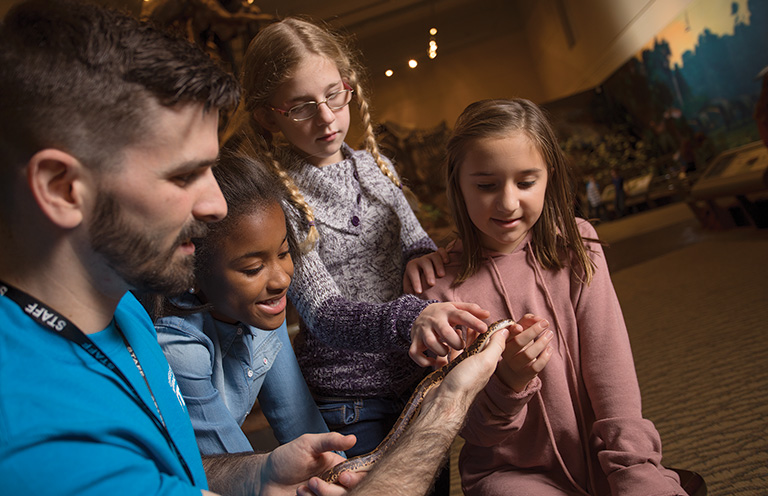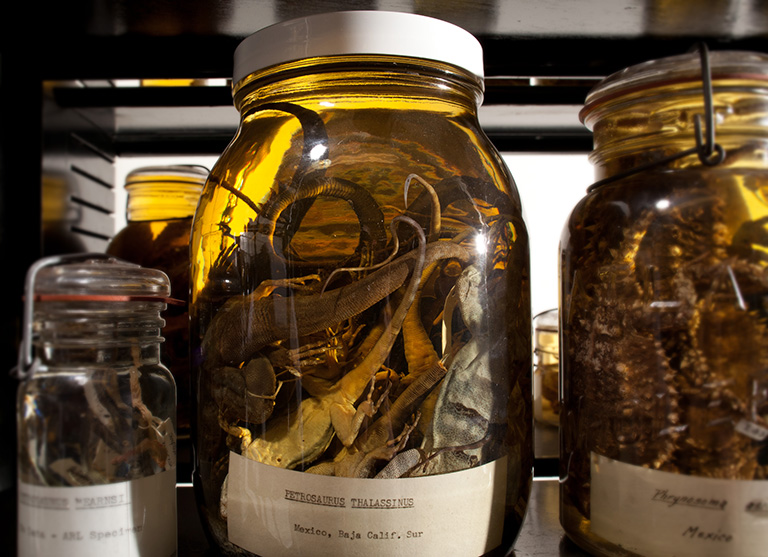“The only good snake is a dead snake.”
Maybe this sentiment stems from their beady eyes. Maybe it’s that they’re cold-blooded and covered in scales seemingly so unlike human skin. Or maybe it’s just because most people have never met a snake like Bob. “Bob is the nicest snake in the whole entire world,” says Mallory Sickle, assistant director of lifelong learning at Carnegie Museum of Natural History, as she handles the five-foot serpent.
He may also be the prettiest. Bob’s back is decorated with alternating bands of rusty stripes and his underside, as smooth as worn leather, includes a pattern of scales that looks a lot like kernels of ornamental maize. One might even think that’s how Bob’s species got its common name, the corn snake.

Corn Snake
But there’s another, more likely origin. Corn snakes are often found in farmers’ fields hunting their favorite meal.“They’re mousers,” says Sickle. “They love to eat the mice that are gobbling up all of the corn. So farmers actually really love having them around.”
No doubt if more people met a reptile like Bob, they’d be a lot less fearful of snakes. Visitors to Carnegie Museum of Natural History have the opportunity to do exactly that as part of the current Reptiles: LIVE! exhibition. The show, created by Peeling Productions at Reptiland, is supplemented by meet and greets with Bob and other reptiles from the museum’s living collection: a pair of worm-like sand boas named Angelina and Xena, an Australian carpet python named Boomer, and Chiquita, a Mexican spiny tailed iguana who loves nothing more than a bite of fresh banana. It also features 19 living dioramas of various lizards, snakes, crocodiles, and turtles, some of which are better introduced behind glass, like the mangrove snakes of South Asia.
“I love mangrove snakes because they’re so striking,” says Jennifer Sheridan, a tropical conservation ecologist and the museum’s new assistant curator of amphibians and reptiles. “They have these bright yellow stripes on a black background.”
While these snakes are beautiful, they’re also dangerous. Just one dose of their venom is enough to kill the rodents and birds they hunt or cause intense, painful swelling in a human. But Sheridan notes that just because the animals can hurt you doesn’t mean they want to.
During a field expedition in Borneo where Sheridan and her team were searching for frogs—her main area of study—she recalls having a close encounter with one of these slithering creatures. She’d been splashing around in the middle of a stream looking for amphibians when the batteries in her headlamp died, so she stopped to change them while the rest of her colleagues went on ahead.
“When I turned my lamp back on, there was a mangrove snake between my feet in the water,” says Sheridan, whose research interests are focused on ecological responses to changes in both climate and habitat and land use.
While Indiana Jones might have been sweating and snarling, Sheridan was confident that the reptile meant her no harm. With her headlamp back in order, she simply stepped over the serpent and waded back toward the group.
The more you know, the less there is to fear.

Visitors can get up close to 19 living dioramas in Reptiles: LIVE!, plus meet members of the museum’s permanent living collection.
This isn’t to say every reptile you see should be picked up and handled. Sickle says that even though she’d spent years handling all manner of animals while working at zoos, it took her a long time to come around to snakes.
“It was a very visceral reaction,” she says. “They’re scary-looking. They slide around. You never know what they’re going to do. “Now I take snakes on a case-by-case basis. I wouldn’t just go pick up any old snake that I find outside, but I know Bob, and I trust Bob.”
Diverse and doting parents
There are more than 10,000 species of reptiles alive today, spread across every continent except Antarctica. And while not all of them are as welcoming as Bob the corn snake, it’s fair to say that these animals are misunderstood at best.
For instance, not all reptiles are cold-blooded. The tegu, a sizable lizard native to South America, can actually increase its own body temperature during its reproductive season—a trick not even scientists thought possible until it was studied in 2016. Others are doting mothers. Female South African pythons stick around for several weeks after their offspring hatch to keep their brood warm. And American alligator mothers will actively respond to the calls of their young and shuttle the little ones out of the nest and into the water using only their fearsome jaws. For a few months, mom will also protect her pod of scaly toddlers from any nearby predators.

A frilled leaf-tailed gecko on exhibit in Reptile LIVE! Photo: Joe McDonald
Saltwater crocodiles are the world’s largest reptiles today, with some specimens stretching up to 17 feet in length from nose to tail. Leatherback sea turtles are no slouches either; as fully grown adults they can sometimes stretch longer than the average human is tall and weigh more than a grizzly bear.
On the other side of the spectrum, the Virgin Islands dwarf gecko is one of the world’s smallest known reptiles. It can curl up comfortably on the face of a dime.
Look in nearly any habitat on Earth and you will find a reptile that’s made a home there. Kenyan sand boas have heads shaped like shovels, which they use to ply through desert sands as if they were water. Mexican mole lizards, odd-looking creatures that lack pigment and are actually not lizards but a kind of reptile called amphisbaenians, come equipped with two massive clawed hands which they use to burrow tunnels underground.
There are also reptiles that have conquered the water, such as coral sea snakes and Galápagos marine iguanas, and those that have mastered the sky, like the flying snakes of South Asia that can leap from a tree branch and then glide the length of a football field.
Scientific wonders
Reptiles are rather diverse when it comes to reproduction. For instance, anyone who’s seen a nesting mother sea turtle on the beach knows that reptiles tend to start their lives inside oblong, leathery eggs. But this is more of a trend than a rule, and many snake species give birth to live young, like the western diamondback rattlesnake on display in Reptiles: LIVE!.
Some female reptiles have yet another trick up their evolutionary sleeves—something you won’t find in any mammal. When confronted with a shortage of males, certain reptile species have the ability to clone themselves and produce offspring without ever having sex. Scientists call this parthenogenesis. Whiptail lizards, Komodo dragons, and monitor lizards like the water monitor, which is currently on display at the museum, are just some of the reptiles that can perform the feat of “virgin birth.”
No wonder scientists have been fascinated with reptiles for centuries.
“We have reptiles in our collection going back to the year 1870,” says Steve Rogers, Carnegie Museum of Natural History’s longtime collection manager for amphibians and reptiles. He’s referring to a monitor lizard that was collected on the Indonesian island of Java.

A jar of Baja blue rock lizards preserved in ethanol and stored in the museum’s Alcohol House. Photo: Joshua Franzos
In all, the museum has nearly 100,000 reptile specimens preserved in jars and stainless-steel tanks, representing some 3,800 species and subspecies from around the world. They’re stored in three stories’ worth of stacks affectionately known as the Alcohol House. (Note: Thanks to a generous grant from the National Science Foundation, parts of this “hidden collection” will eventually be open to the public.)
But what good is a preserved,148-year-old monitor lizard specimen?
Depending on where and when an animal was collected, that specimen can serve as a snapshot of what it was to be a monitor lizard so many years ago. “Each specimen is one of a kind,” says Rogers. And these time capsules, many of which are preserved in ethanol, can be used to study the evolution of species or to better understand the way an animal has interacted with its environment.
Perhaps no assortment of jars illustrates this point better than the museum’s treasure trove of 38,000 turtle specimens, the largest such collection of North American freshwater turtles in the world. Parts of this collection were donated by Michael Ewert, a scientist who studied incubation temperature in more than 100 species of turtles. His gift of more than 14,000 turtle hatchlings documents the role that incubation temperature plays in whether individuals develop into males or females.

Kaylin Martin catalogs turtles in the museum’s Alchohol House, home to its collection of reptiles and amphibians. Photo: Kathy Hair
“Hotter temperatures will yield females, and lower temperatures will yield males,” says Kaylin Martin, a curatorial assistant funded by the National Science Foundation grant and tasked with cataloging a recent large donation of turtles into the museum’s vast assortment of preserved reptiles and amphibians. “Think: hot chicks, cool dudes.”
Understanding how this works is critically important as air and water temperatures continue to rise all over the planet due to climate change. A study conducted on Australia’s Ingram Island, which is one of the Pacific Ocean’s largest green sea turtle rookeries, discovered that more than 99 percent of the hatchlings on the island are now females. Due to changes in temperature, the males are simply disappearing, and green sea turtles are not one of the reptiles known to utilize parthenogenesis.
This isn’t just bad news for the turtles. It could be detrimental to the innumerous species that depend on these animals for their livelihoods. Young sea turtles are an important food source for birds, crabs, and fish; and, as juveniles, these reptiles become predators of fish eggs, jellyfish, worms, and crustaceans. Adult green sea turtles eat mostly algae and sea grasses. Take these animals away and part of the food web falls apart.

A star tortoise similar to one on display in Reptiles: LIVE!
Another example: In the southeast United States, gopher tortoises and the burrows they create have been found to support around 350 other species, from indigo snakes and rattlers to gopher frogs, burrowing owls, and countless species of arthropods, such as insects, spiders, or crustaceans.
“So if you lose the gopher tortoise, you’d potentially lose all those other species,” says Martin.
Sadly, the gopher tortoises and green sea turtles are not alone in their plight. Due to habitat destruction, overexploitation of turtles for food, the pet industry, and climate change, a 2018 study published in BioScience concluded that approximately 61 percent of all turtle species are now considered threatened or already extinct. As such, turtles are among the most imperiled groups of animals on Earth.
This is why natural history collections are so vital, says Martin. All those jars of preserved specimens are like backup files for what exists out in the real world.
Martin is so enamored with the Alcohol House and its contents that the Texas-native plans to add a tattoo on her arm of a specimen jar filled with various reptiles and amphibians native to Pennsylvania—a nod to the strength of the museum’s collections and a permanent reminder of her time spent among the time capsules.
Reptiles: LIVE! is presented by Green Mountain Energy and sponsored by Highmark Blue Cross Blue Shield, Baierl Subaru, Baierl Toyota, and PA Virtual Charter School.
Part of this story is based upon work supported by the National Science Foundation under Grant No.1557428. Any opinions, findings, and conclusions or recommendations expressed do not necessarily reflect the views of the National Science Foundation.







